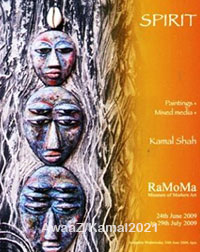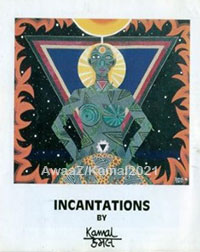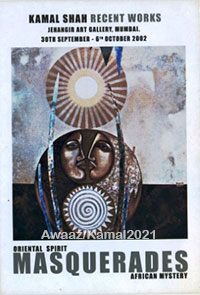Kamal Shah is a Kenyan artist who has, since the 1990’s, blazed the Kenyan landscape and carved a special niche for himself and his work. His African spirit embraces Indian and European cultures and the result is a multitude of themes, fluorescent and metallic colours and bold, stark strokes.
Explaining an artwork is a daunting undertaking, especially if it is not realistic or illustrative. Kamal Shah explains his creative process thus: ‘I am at a point where I am beginning to see how my life has made itself while I have been living it how naturally and inevitably I have become an artist.

As I paint I am conscious of observing and feeling what goes on both inside and outside myself; certain aspects of what is happening adhere to me, as if inevitably magnetised by a centre of mystic gravity. I have learnt to trust this centre and to rely on its acuity and to go along with its choices although the centre itself remains mysterious to me.’
Rajiv Bhatia, a former Indian High Commissioner to Kenya, in his tribute to Kamal Shah in the Indian Perspectives issue of June 2002 described him thus: ‘Among Kenyan artists of Indian origin, Kamal is the undisputed doyen and is perhaps one of the most written about contemporary artists of Kenya today. Kamal, with his clean-shaven head, round shaped eyeglasses and piercing gaze, bears a fascinating profile with his ‘third eye’ that constantly watches people and the things surrounding him.’
Kamal Shah has been part of 34 selected group shows and held 20 solo exhibitions as well being awarded ‘First Prize in the Mixed Media’ category at the ‘First Juried Contemporary Kenyan Art Exhibition’. He has been commissioned by corporates such as Barclays Bank (now ABSA) and Kenya Airways and created a Mural for Sagana State Lodge. His accomplishments indeed are laudable.

AwaaZ presents here a few of the portrayals of Kamal’s artistry embedded in the reviews of his art exhibitions. In his first independent art venture, Kichaka, he specialized in printing avant-garde textiles. In ‘Mutant Cultures’ he is described as, ‘breaking all boundaries, transcending cultures and skimming along universal planes of multi-ethnicity. He creates very original and luminous paintings which are hard to define and difficult to categorize’.
In ‘Incantations’ (Taj Art Gallery, Mumbai, India, 1996), Dnyaneshwar Nadrkarni said of Kamal, ‘he conjures up a whole world of magic, mesmerizing us with his supreme differentness, his depth and beauty … the colours, the lines, the forms all act and react against one another as if they were part of a brilliantly architecture construction’. ‘He is constantly playing hide and seek with vision and reality, fantasy and imagination … his work is suffused with radiant illuminating light, colour and turbulence’ was the remark in ‘Face to Face’ (Denmark, 1993).

‘Spirit’ (RaMoMa, Nairobi, Kenya, 2009) draws attention to the ‘more transpersonal and universally spiritual tone’ of Kamal’s art. ‘Works that try to create a healing path with the power to uplift, inspire and project an ideal of what we and our wounded world could become.’ To a press reporter in 1996, Kamal said: ‘My people are not of any ethnic origin’.
‘I am not naïve about the existence of evil and suffering but I do not wish to represent it … the overwhelming impression should be of transcendence and tranquillity,’ Kamal Shah says emphatically to John Sibi-Okumu in a 2006 interview.
The artist gives us (the viewer/reader) a glimpse into his work ethic: ‘I learned a long time ago to just make art that feels right and then put it out there. To worry if something is good or not is creativity crippling, indeed. My hope is that if I make something that comes from a genuine place, it will be received genuinely. What more can you ask for, really?’






